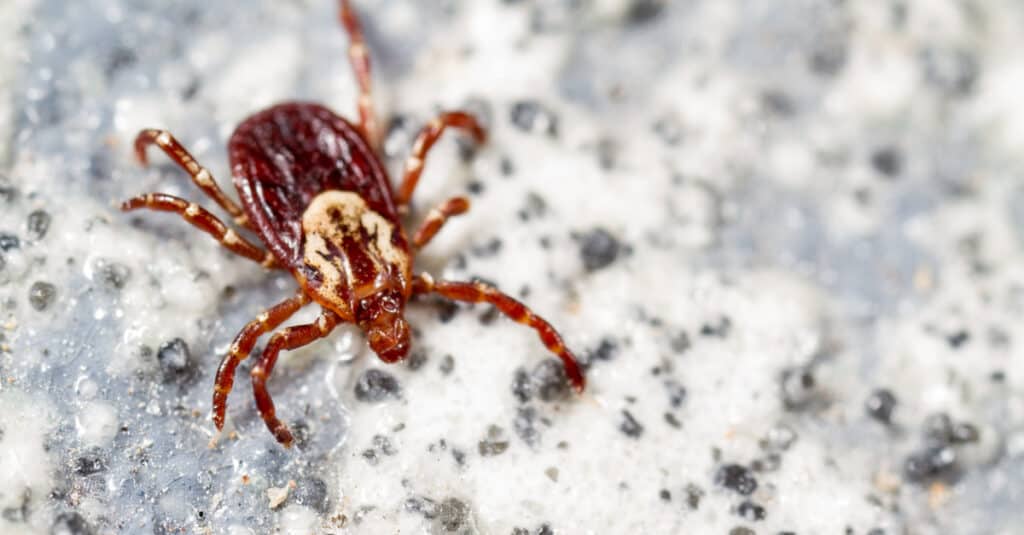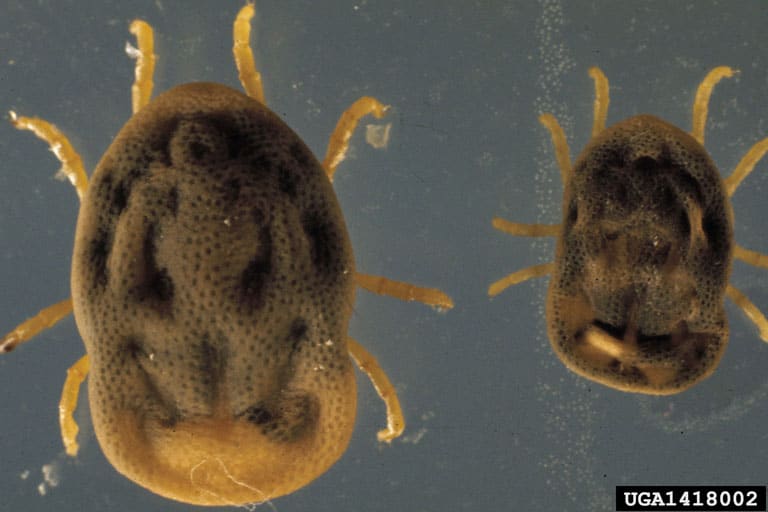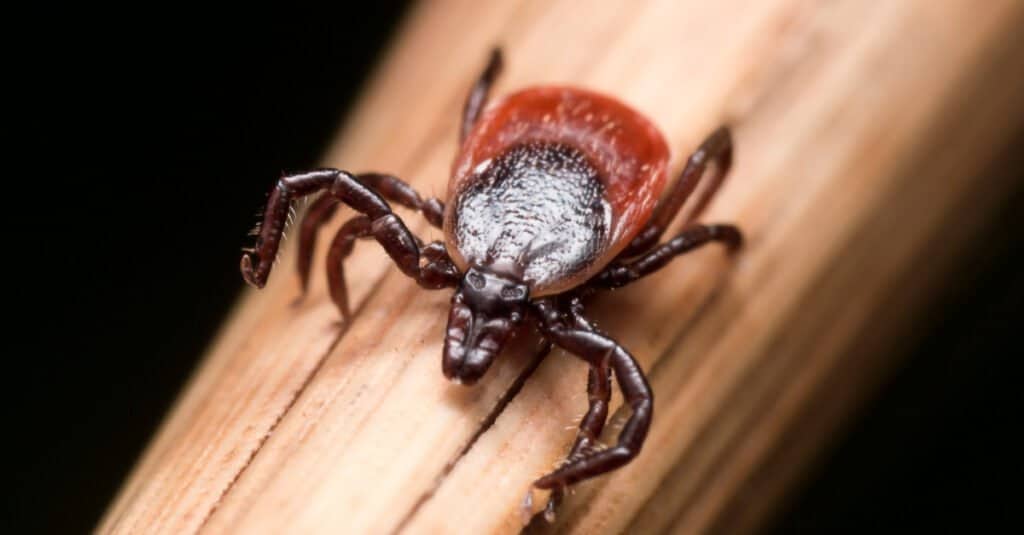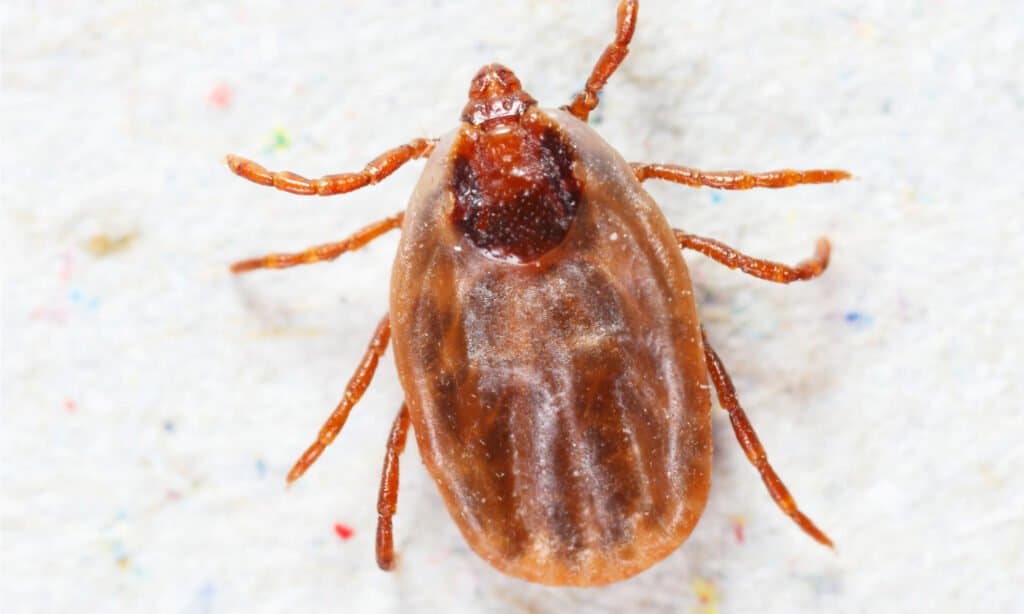There are a whopping 19 species of ticks in Mississippi. Like mosquitos, ticks live off of blood, and some species bite dogs, humans, or both. Despite the fact that they’re bloodsuckers, ticks are generally harmless. What’s not harmless are the diseases, pathogens, and bacterial infections ticks carry. Because they drink our blood, they are able to spread all those nasty pathogens onto humans and other animals. The most concerning of these bacterial infections is Lyme disease. But, not all ticks in Mississippi transmit this deadly infection.
Here, we’ll take a closer look at six of the most common tick species in Mississippi. We’ll learn how to differentiate them, what each species most commonly preys on, and how to avoid them. Read on to learn more about six of the most common ticks in Mississippi.
American Dog Tick (Dermacentor variabilis)

American dog ticks feed mostly on dogs.
©Elliotte Rusty Harold/Shutterstock.com
American dog ticks are one of the most common ticks in Mississippi and in North America. They’re hard-bodied, with oval-shaped, mahogany-colored thoraxes and visible heads. Both males and females have eight legs as adults and share similar coloring. Male American dog ticks have a slightly more mottled appearance, while females are almost entirely brown.
These ticks feed mostly on dogs, though they will attach to anything that makes itself available. Human bites can turn deadly—the American dog tick is the number one vector of Rocky Mountain spotted fever in the eastern United States. These ticks in Mississippi live mostly in forests, which is where they get their nickname, the wood tick.
Spinose Ear Tick (Otobius megnini)

Spinose ear ticks attach mainly to the ears.
©Mat Pound-USDA Agricultural Research Service Country-United States / Creative Commons – License
Spinose ear ticks, as their name suggests, attach mainly to the ears. This may sound terrifying, but don’t worry: these ticks in Mississippi prefer drinking the blood of cattle, not people. Only young spinose ear ticks sometimes bite people, though this is rare. Spinose ear ticks are much more likely to attach to the ears of dogs, cats, deer, horses, sheep, and mules.
These ticks have gray bodies that swell and become amorphous once fed. Males and females have similar appearances.
Lone Star Tick (Amblyomma americanum)

Lone star ticks are disease vectors.
©iStock.com/epantha
One of the most easily recognizable ticks in Mississippi, the lone star tick gets its name from the appearance of the female. Female lone star ticks are light brown, with a single tan dot in the middle of their back. Males lack this dot and instead have several small tan markings around their thorax.
These ticks prefer four-legged hosts, like white-tailed deer, but will feed on anything that strays too close. They don’t carry Rocky Mountain spotted fever, but they are the main vector for human monocytic ehrlichiosis. Females can lay up to 5,000 eggs in a single sitting, after which they die, making room for the next generation of ticks.
Deer Tick (Ixodes scapularis)

Deer ticks take one host per life cycle—larva, nymph, and adult.
©Steven Ellingson/Shutterstock.com
Another common species of ticks in Mississippi is the deer tick, commonly known as the black-legged tick. Deer ticks have long, ovoid bodies and large heads that are clearly visible from above. Males and females have fairly different appearances, though both have black legs. Black-legged ticks are easy to recognize as they’re the only ticks in Mississippi to have black legs.
Female deer ticks have red-brown bodies with dark brown heads and scuta (the shields on their shoulders). Males are mottled light and dark brown. These ticks feed mainly on deer but won’t hesitate to feed off a human or dog that strays across their path.
Gulf Coast Tick (Amblyomma maculatum)

Gulf coast ticks feed on large mammals.
©iStock.com/cturtletrax
Gulf coast ticks occur only in the coastal regions of the Atlantic and Gulf coasts. They’re one of the most common ticks in Mississippi. Luckily, humans aren’t high on the menu for these ticks. Instead, they prefer feeding on large mammals like deer and cattle.
Female gulf coast ticks have distinct dark brown bodies with light brown and tan markings. Males are entirely yellow-brown in color, with muted darker brown mottling. They’re larger than other species of ticks in Mississippi, though not as dangerous.
Brown Dog Tick (Rhipicephalus sanguineus)

Brown dog tick is found almost anywhere there are human structures and dogs.
©7th Son Studio/Shutterstock.com
Unlike other ticks in Mississippi, the brown dog tick spends most of its life inside. This parasitic blood drinker preys almost entirely on canines, though it can occasionally feed on humans. Female brown dog ticks are light brown, with small heads. Males are darker brown, with red and black markings. They spend most of their lives indoors, near dogs.
Do Ticks in Mississippi have Lyme Disease?
Out of all the ticks in Mississippi, only one species carries Lyme disease. That dubious distinction belongs to the deer tick, or black-legged tick. Unfortunately, these ticks often bite humans, which means that Lyme disease is the most prevalent vector-borne illness in the United States. If left untreated, this bacterial infection can quickly turn chronic and affect nearly every system of the body.
How to Avoid Ticks in Mississippi
In order to avoid ticks in Mississippi, it’s important to wear light-colored, long-sleeved shirts and long pants. Bug repellent is also helpful when going outdoors. Be mindful of the time of year as well—ticks like to come out in the spring and summer months. And, after any outdoor activity, be sure to check yourself for ticks.
The photo featured at the top of this post is © iStock.com/nechaev-kon
Thank you for reading! Have some feedback for us? Contact the AZ Animals editorial team.






